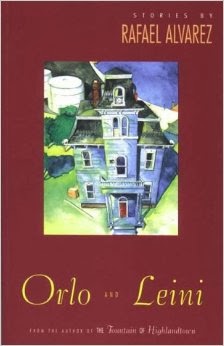Rafael Alvarez is the author of the new story collection Tales from the Holy Land. His other books include Orlo and Leini, The Fountain of Highlandtown, Storyteller, The Wire: Truth Be Told, and Hometown Boy: The Hoodle Patrol and Other Curiosities of Baltimore. He spent many years as a reporter for The Baltimore Sun, and also wrote for the HBO show The Wire. He lives in Baltimore.
Q: In the introduction to your book, Afaa Michael Weaver
writes, "There is a magic in Baltimore, and Alvarez lives inside of it. He
breathes it. He abides in its faith." What is it about Baltimore that
connects you to it and its stories?
A: My family, the rituals of youth (from my first communion
to my first beer in Fells Point/first kiss/first concert). The fact that for
more than 20 years at The Baltimore Sun I got paid to wander the streets and
knock on the doors of strangers and ask them the most intimate of questions (What
year did your mother win that duckpin bowling trophy above the fireplace?)
The fact that my father had the coolest job in the world
that was hard-wired to the pulse of Baltimore: a harbor tugboat engineer. The
fact that blood relations before me walked the cobblestones of East Baltimore
as surely as Isaac Bashevis Singer's forebears walked the rutted roads of
Leoncin.
Q: How did you select the title, "Tales from the Holy
Land"?
A: I began calling East Baltimore "the holy land"
as a joke back in the days when I was a young reporter at the Sun and after the
late rewrite shift would gather a bunch of friends (from inside and outside the
newspaper) to join me at Miss Bonnie's Elvis Bar (corner of Fleet and Port
streets, mentioned often in my stories, the place where Basilio is struck sober
on Aug. 27, 1990) and like a lot of things in my life, the fun of the joke
began to morph into something more serious.
I saw it as the most profound statement I could make about
how important Baltimore - particularly the neighborhoods east of the Inner Harbor - is to me.
Q: You return frequently to some of your characters, Orlo
and Leini for example. As you're writing about them at different points in
their lives, have you already planned out what will happen to them, or do they
offer surprises when you return to write about them again?
A: I have a broad sense of what many of these characters'
fates will be (for example, I know Basilio paints until the day he falls off of
some scaffolding in his early 80s; I know that Basilio's daughter India
(mentioned in “Nine Innings in Baltimore”) will grow up to be the private tutor
of Gloria, the daughter of the Virgin Ruthie from an earlier story (“The
Annunciation” in Fountain of Highlandtown) but what I don't know is what they
will do in very specific situations on specific days currently missing from
larger narrative.
My work is one big story - a mural of the margins of Baltimore
from about 1920 to 2040 - and I fill the mural in one panel at a time. In time,
the panels connect and I will then package those stories into the next book.
My characters always surprise me: Leini much more fiercely
independent - despite the broken torch she carries for Orlo - than I had first
thought. Sometimes I remember these people in my prayers.
Q: How did you pick the photographs that accompany the
stories throughout the book?
A: I commissioned most of the photos from Baltimore artists
I respect. I gave them the story and said, “Have at it.” No one disappointed. The
photos credited to “Macon Street Books” were taken by me.
Q: What are you working on now?
A: A script for a feature film called "The Baltimore
Crab Cake Wars" and a new book of stories. I write fiction every morning
and every evening. In between I chase journalism to pay the bills.
My newest non-fiction passion is using old Baltimore recipes
to tell family histories, both my family and others. Here and here are two recent
examples.
Q: Anything else we should know?
A: Just that I will be
reading from the new book in Water Valley, Miss., at 4 p.m. on Sunday, March 2.
That the book is available from Amazon, and mostly that I hope you bring your own sensibility to the stories, talk about what moved you and why.
--Interview with Deborah Kalb




No comments:
Post a Comment